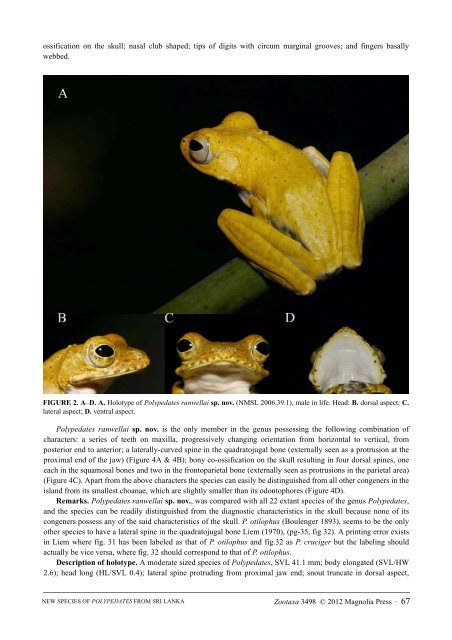A New Species of Polypedates Tschudi
A new species of frog tentatively assigned to the genus Polypedates is described from the Gilimale forest reserve of the Sabaragamuwa province of Sri Lanka. This tree frog is characterized by unique osteological characteristics in the skull which distinguish it from all other congeners, such as the presence of a series of maxillary teeth progressively changing orientation from horizontal to vertical from …
A new species of frog tentatively assigned to the genus Polypedates is described from the Gilimale forest reserve of the Sabaragamuwa province of Sri Lanka. This tree frog is characterized by unique osteological characteristics in the skull which distinguish it from all other congeners, such as the presence of a series of maxillary teeth progressively changing orientation from horizontal to vertical from …
Create successful ePaper yourself
Turn your PDF publications into a flip-book with our unique Google optimized e-Paper software.
TERMS OF USE<br />
This pdf is provided by Magnolia Press for private/research use.<br />
Commercial sale or deposition in a public library or website is prohibited.<br />
ossification on the skull; nasal club shaped; tips <strong>of</strong> digits with circum marginal grooves; and fingers basally<br />
webbed.<br />
FIGURE 2. A–D. A. Holotype <strong>of</strong> <strong>Polypedates</strong> ranwellai sp. nov. (NMSL 2006.39.1), male in life. Head: B. dorsal aspect; C.<br />
lateral aspect; D. ventral aspect.<br />
<strong>Polypedates</strong> ranwellai sp. nov. is the only member in the genus possessing the following combination <strong>of</strong><br />
characters: a series <strong>of</strong> teeth on maxilla, progressively changing orientation from horizontal to vertical, from<br />
posterior end to anterior; a laterally-curved spine in the quadratojugal bone (externally seen as a protrusion at the<br />
proximal end <strong>of</strong> the jaw) (Figure 4A & 4B); bony co-ossification on the skull resulting in four dorsal spines, one<br />
each in the squamosal bones and two in the frontoparietal bone (externally seen as protrusions in the parietal area)<br />
(Figure 4C). Apart from the above characters the species can easily be distinguished from all other congeners in the<br />
island from its smallest choanae, which are slightly smaller than its odontophores (Figure 4D).<br />
Remarks. <strong>Polypedates</strong> ranwellai sp. nov., was compared with all 22 extant species <strong>of</strong> the genus <strong>Polypedates</strong>,<br />
and the species can be readily distinguished from the diagnostic characteristics in the skull because none <strong>of</strong> its<br />
congeners possess any <strong>of</strong> the said characteristics <strong>of</strong> the skull. P. otilophus (Boulenger 1893), seems to be the only<br />
other species to have a lateral spine in the quadratojugal bone Liem (1970), (pg-35, fig 32). A printing error exists<br />
in Liem where fig. 31 has been labeled as that <strong>of</strong> P. otilophus and fig.32 as P. cruciger but the labeling should<br />
actually be vice versa, where fig. 32 should correspond to that <strong>of</strong> P. otilophus.<br />
Description <strong>of</strong> holotype. A moderate sized species <strong>of</strong> <strong>Polypedates</strong>, SVL 41.1 mm; body elongated (SVL/HW<br />
2.6); head long (HL/SVL 0.4); lateral spine protruding from proximal jaw end; snout truncate in dorsal aspect,<br />
NEW SPECIES OF POLYPEDATES FROM SRI LANKA<br />
Zootaxa 3498 © 2012 Magnolia Press · 67















